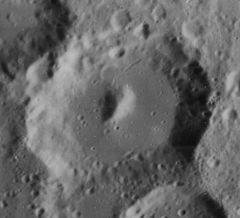Lilius (crater)
 Lunar Orbiter 4 image | |
| Coordinates | 54°30′S 6°12′E / 54.5°S 6.2°ECoordinates: 54°30′S 6°12′E / 54.5°S 6.2°E |
|---|---|
| Diameter | 61 km |
| Depth | 3.0 km |
| Colongitude | 354° at sunrise |
| Eponym | Aloysius Lilius |
Lilius is a lunar impact crater that is located in the rugged southern highlands of the Moon. It lies to the north of the crater Zach, and south-southwest of Cuvier. Just to the southeast is the slightly larger Jacobi. The crater is named after the inventor of the Gregorian calendar, Aloysius Lilius.
The outer rim of Lilius has been worn down and rounded, particularly to the northwest where the inner wall protrudes farther into the interior floor. The lowest portion of the rim is to the south, adjacent to a crater attached to the southeast part of the outer wall. The interior floor is relatively flat and featureless, but there is a wide, domed central peak at the midpoint.
Satellite craters[]
By convention these features are identified on lunar maps by placing the letter on the side of the crater midpoint that is closest to Lilius.
| Lilius | Latitude | Longitude | Diameter |
|---|---|---|---|
| A | 55.4° S | 8.8° E | 41 km |
| B | 53.0° S | 3.8° E | 29 km |
| C | 54.4° S | 3.3° E | 40 km |
| D | 50.6° S | 3.0° E | 51 km |
| E | 50.1° S | 2.9° E | 38 km |
| F | 49.4° S | 1.7° E | 43 km |
| G | 50.0° S | 0.7° E | 7 km |
| H | 50.5° S | 0.8° E | 9 km |
| J | 56.3° S | 1.8° E | 13 km |
| K | 53.6° S | 2.2° E | 23 km |
| L | 54.9° S | 2.5° E | 6 km |
| M | 56.2° S | 2.9° E | 11 km |
| N | 49.0° S | 2.8° E | 5 km |
| O | 55.4° S | 3.6° E | 7 km |
| P | 55.9° S | 3.9° E | 4 km |
| R | 54.6° S | 4.4° E | 9 km |
| S | 52.8° S | 5.9° E | 14 km |
| T | 55.9° S | 7.5° E | 5 km |
| U | 53.5° S | 7.6° E | 8 km |
| W | 53.6° S | 8.3° E | 9 km |
| X | 53.5° S | 9.9° E | 4 km |
References[]
- Andersson, L. E.; Whitaker, E. A. (1982). NASA Catalogue of Lunar Nomenclature. NASA RP-1097.
- Blue, Jennifer (July 25, 2007). "Gazetteer of Planetary Nomenclature". USGS. Retrieved 2007-08-05.
- Bussey, B.; Spudis, P. (2004). The Clementine Atlas of the Moon. New York: Cambridge University Press. ISBN 978-0-521-81528-4.
- Cocks, Elijah E.; Cocks, Josiah C. (1995). Who's Who on the Moon: A Biographical Dictionary of Lunar Nomenclature. Tudor Publishers. ISBN 978-0-936389-27-1.
- McDowell, Jonathan (July 15, 2007). "Lunar Nomenclature". Jonathan's Space Report. Retrieved 2007-10-24.
- Menzel, D. H.; Minnaert, M.; Levin, B.; Dollfus, A.; Bell, B. (1971). "Report on Lunar Nomenclature by the Working Group of Commission 17 of the IAU". Space Science Reviews. 12 (2): 136–186. Bibcode:1971SSRv...12..136M. doi:10.1007/BF00171763. S2CID 122125855.
- Moore, Patrick (2001). On the Moon. Sterling Publishing Co. ISBN 978-0-304-35469-6.
- Price, Fred W. (1988). The Moon Observer's Handbook. Cambridge University Press. ISBN 978-0-521-33500-3.
- Rükl, Antonín (1990). Atlas of the Moon. Kalmbach Books. ISBN 978-0-913135-17-4.
- Webb, Rev. T. W. (1962). Celestial Objects for Common Telescopes (6th revised ed.). Dover. ISBN 978-0-486-20917-3.
- Whitaker, Ewen A. (1999). Mapping and Naming the Moon. Cambridge University Press. ISBN 978-0-521-62248-6.
- Wlasuk, Peter T. (2000). Observing the Moon. Springer. ISBN 978-1-85233-193-1.
- LQ27 quadrangle
- Impact craters on the Moon
